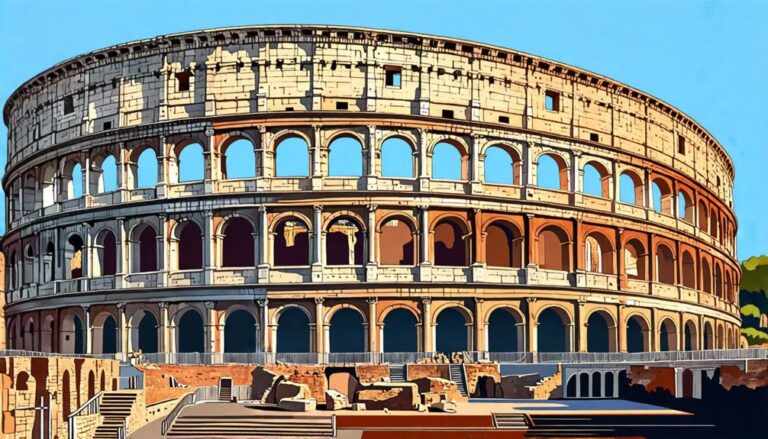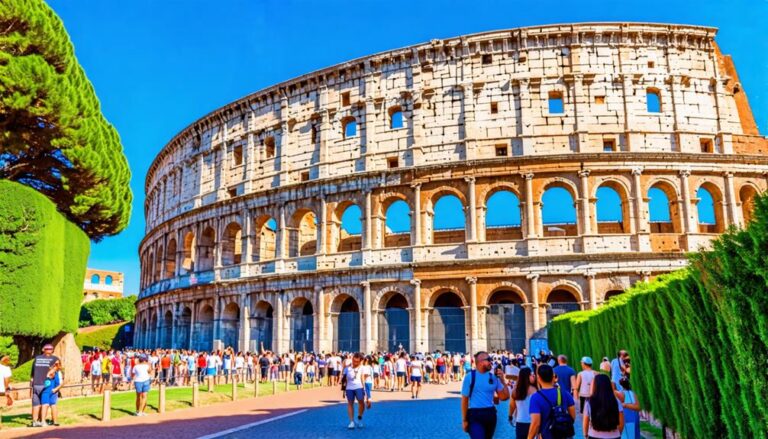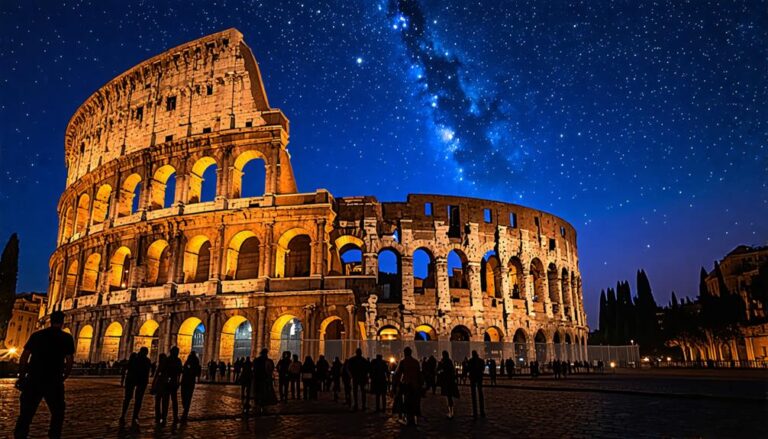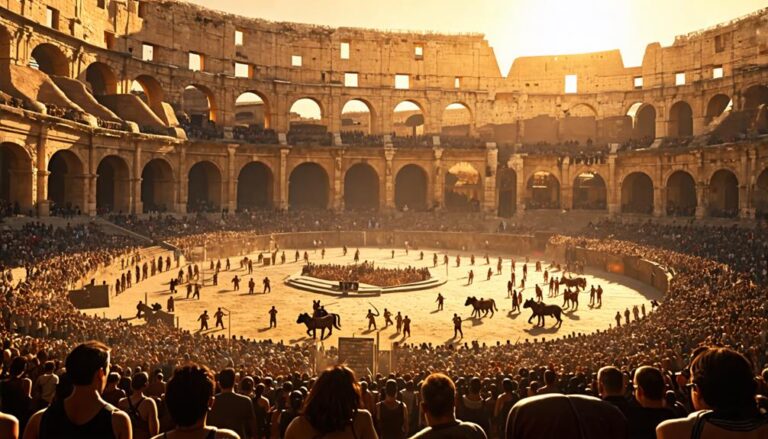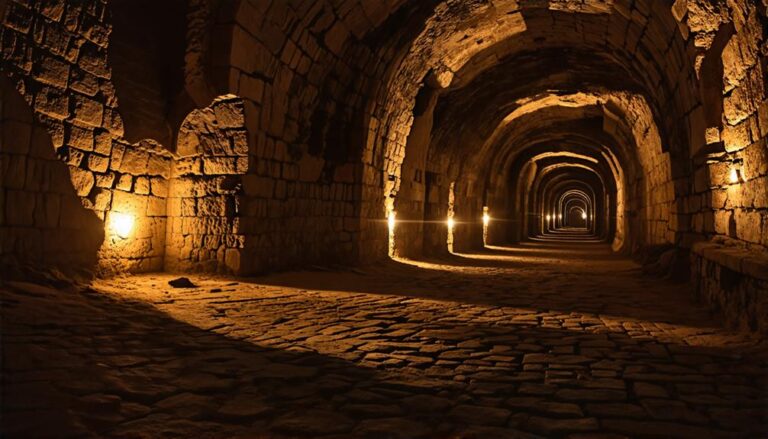The Colosseum: A UNESCO World Heritage Site
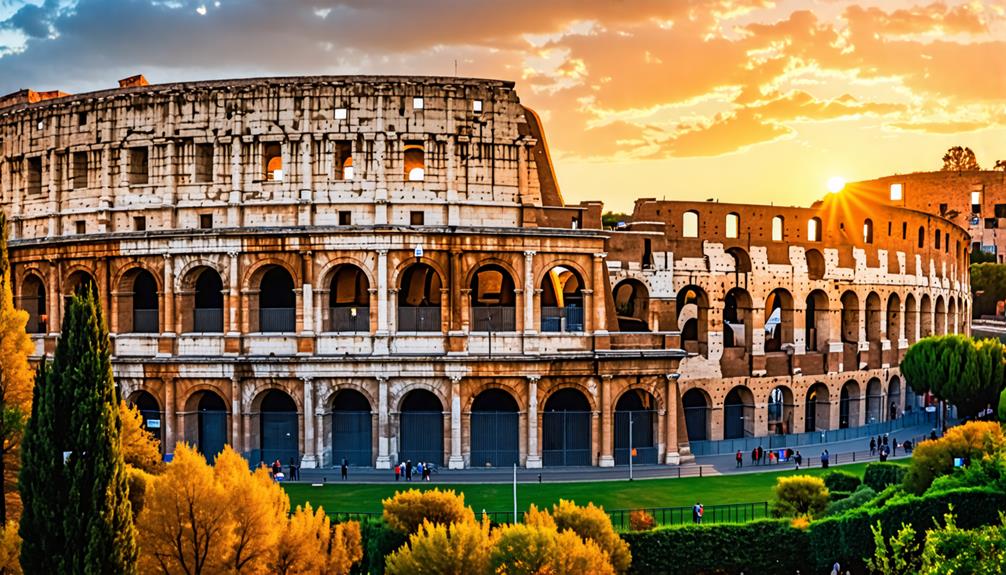
The Colosseum is an ancient marvel you should not miss on your vacation to Rome. Completed in the late 1st century CE, this colossal amphitheater stands as a testament to Rome's architectural brilliance and societal values. As the world's largest amphitheater, it can hold 50,000 spectators and once hosted gladiatorial contests and mock naval battles. These events were the pinnacle of public entertainment in ancient Rome.
Designated as a UNESCO World Heritage Site in 1980, the Colosseum symbolizes Rome's cultural splendor. Its unique elliptical design and advanced engineering have influenced modern structures around the globe.
Ongoing preservation efforts and archaeological studies keep uncovering its historical significance. This ensures its legacy endures for future generations. Exploring its corridors and stands, you will get a sense of the grandeur and spectacle that once filled this iconic arena.
Plan your visit and immerse yourself in the full story and lasting impact of the Colosseum. It's not just a sight to see, but an experience that connects you with history.
Key Takeaways
- The Colosseum, a UNESCO World Heritage Site since 1980, is a must-see for anyone visiting Rome.
- This iconic structure showcases the grandeur of the Roman Empire and reveals ancient societal values of public entertainment.
- Preservation efforts protect the Colosseum from environmental threats and keep its unique architecture intact.
- With millions of visitors each year, the Colosseum stands as a significant cultural heritage site and an educational gem.
When planning your Rome vacation, put the Colosseum at the top of your list. It's a piece of history you won't want to miss.
Colosseum Overview
Why does the Colosseum, completed in the late 1st century CE, continue to fascinate millions of visitors each year? This massive structure, originally called the Flavian Amphitheater, stands as the largest amphitheater in the world. It symbolizes the grandeur of the Roman Empire. The Colosseum's elliptical design and tiered seating exemplify ancient Roman architecture, showcasing the ingenuity and engineering skill of the time.
The Colosseum, a UNESCO World Heritage Site, holds immense cultural and historical value. It once hosted gladiator fights, mock naval battles, and beast combats. These events served as the central hub of entertainment in ancient Rome, entertaining and displaying the empire's power and control over nature and man.
Ongoing preservation efforts are crucial to maintaining the structural integrity of this monumental amphitheater. These efforts ensure that the Colosseum remains a key element of Rome's cultural heritage and identity.
As we walk through its ancient arches and look upon the vast arena, we're reminded of the rich history and enduring legacy of the Roman Empire. The Colosseum's allure lies in its ability to connect us with a bygone era, resonating with our desire for freedom and exploration.
UNESCO World Heritage Status
The Colosseum's recognition as a UNESCO World Heritage Site in 1980 highlights its immense cultural and historical value. This status points to the Colosseum as a symbol of the Roman Empire and its reflection of societal values, such as public entertainment and grand spectacles in ancient Rome. Since its designation, the Colosseum has seen extensive renovation and preservation to maintain its structural integrity and protect it from environmental threats.
| Key Aspect | Details |
|---|---|
| UNESCO Designation | 1980 |
| Cultural Significance | Reflects ancient Roman values |
| Preservation Efforts | Ongoing renovations and studies |
Ongoing archaeological studies and conservation projects have not only preserved the Colosseum but also deepened our understanding of its historical context. Millions of tourists visit the site every year, drawn by its rich cultural significance and the legacy of ancient Roman architecture and engineering. This large number of visitors highlights the importance of promoting cultural heritage and education.
| Visitor Attraction | Millions annually |
|---|---|
| Historical Value | Iconic symbol of Roman Empire |
| Legacy | Ensures future generations' access |
Exploring and preserving the Colosseum contributes to a collective legacy that honors the ingenuity and spirit of ancient Rome. Through UNESCO's recognition, the Colosseum stands as a testament to the enduring value of cultural heritage and historical awareness.
For those planning a vacation to Rome, a visit to the Colosseum offers a trip back in time. Standing in this grand amphitheater, you can almost hear the echoes of ancient crowds and feel the grandeur of Roman engineering. The structure not only serves as a historical monument but also as a vivid reminder of the cultural and societal advancements of ancient Rome.
Architectural Significance
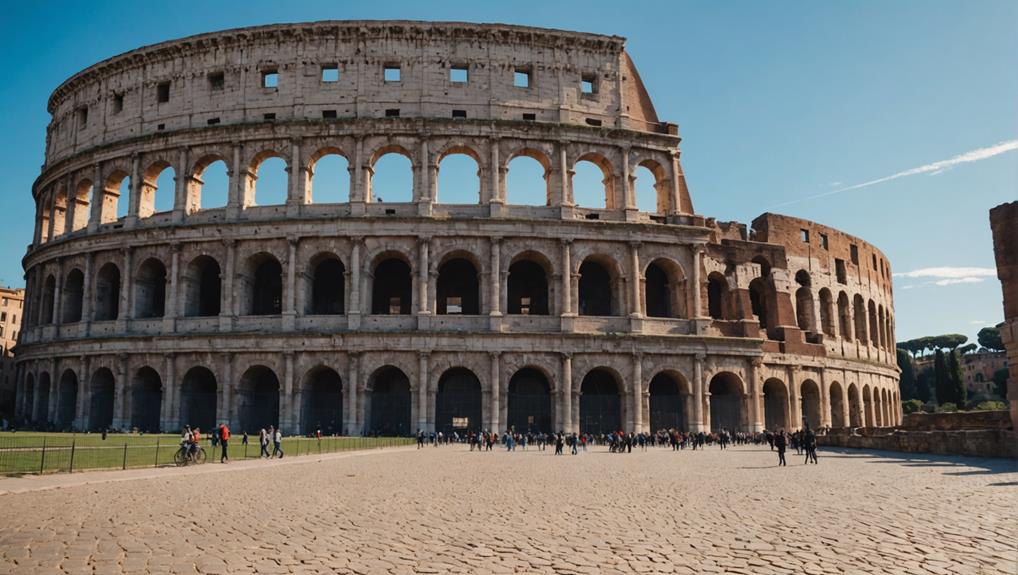
The Colosseum stands as a marvel of ancient engineering and is a must-see for anyone vacationing in Rome. This grand amphitheater, the largest in the world, stretches 189 meters in length, 156 meters in width, and stands 48 meters tall. Its elliptical shape shows the ingenuity of Roman engineering, using a blend of concrete and stone.
The Colosseum's architectural design reveals an advanced system of vaults and arches, giving it remarkable structural integrity. It could seat about 50,000 spectators, making it a pioneer in public entertainment venues. The tiered seating guaranteed excellent views for everyone. This design has influenced modern amphitheaters and stadiums worldwide.
The external facade, once adorned with marble and travertine stone, showcased the grandeur of Roman architecture. Though much of this decor has eroded or been repurposed, it still holds a majestic presence. As a UNESCO World Heritage Site, the Colosseum is a historical monument and a testament to human creativity and engineering prowess. Its enduring legacy shapes our architectural landscape, reminding us of the boundless potential of human innovation.
If you're planning a vacation to Rome, the Colosseum is a sight you can't miss. Its sheer size and intricate design will leave you in awe.
Historical Context
When planning a vacation to Rome, the Colosseum is a must-see. This iconic structure, commissioned by Emperor Vespasian in 70-72 CE and completed by his son Titus in 80 CE, stands as a monumental symbol of the Flavian dynasty. Located in the heart of ancient Rome, it served as a venue for major monuments and public spectacles, reflecting the social and cultural fabric of the Roman Empire.
The Colosseum's primary function was to host gladiatorial contests. Warriors fought to the death before crowds of 50,000 to 80,000 spectators. These events showcased not only the bravery of the gladiators but also the architectural ingenuity of the arena. Advanced construction techniques like arches and vaults were used.
Significant historical events, including the martyrdom of early Christians, contributed to the Colosseum's enduring legacy. As a UNESCO World Heritage Site, it continues to be a reflection of the grandeur and complexity of ancient Rome's historical events and public life.
| Historical Context | Details | Impact |
|---|---|---|
| Emperor Vespasian | Commissioned 70-72 CE | Flavian dynasty symbol |
| Public Spectacles | Gladiatorial contests | Social and cultural reflection |
| Martyrdom | Early Christians | Lasting legacy in history |
When you visit, imagine the roar of the crowd and the spectacle of the games. The Colosseum is not just a relic of the past; it is a window into the soul of ancient Rome.
Current Status and Usage
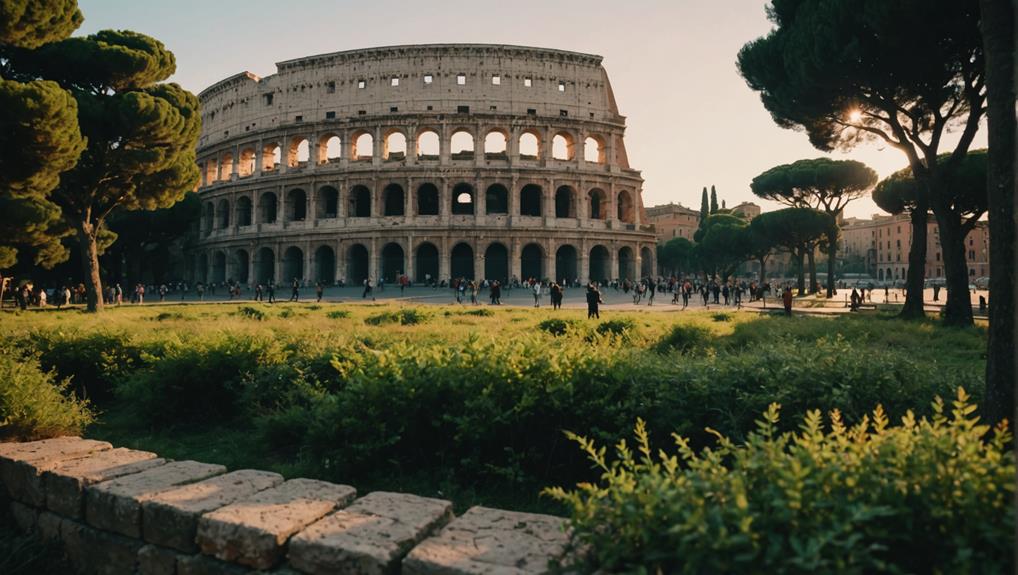
[Vacations to Rome: Sightseeing the Colosseum]
Millions of visitors flock to the Colosseum every year. Its rich historical significance and captivating cultural events draw people from around the world. As a UNESCO World Heritage Site, the Colosseum embodies ancient Roman society and its architectural brilliance. Our fascination with this iconic structure comes from both its storied past and current preservation efforts.
Extensive conservation work is underway to maintain the Colosseum's structural integrity. These initiatives are crucial for visitor safety and preserving the site's historical value. Tourists can marvel at its grandeur through guided tours that delve into its history and role in Roman society.
Ongoing archaeological studies continue to reveal new insights about the Colosseum. These discoveries enrich our understanding of its function and importance. They also help us appreciate the ingenuity of Roman engineering and the cultural heritage it represents.
The Colosseum hosts a variety of cultural events and exhibitions. These activities engage visitors and keep its legacy alive. They allow people to connect with the past in a meaningful way, fostering a deeper appreciation for this unique attraction.
Here's a glimpse of the Colosseum's current status:
- Tourist Attraction: Millions visit annually.
- Conservation Efforts: Ongoing to guarantee structural integrity.
- Cultural Events: Various exhibitions and events hosted.
Frequently Asked Questions
How Many UNESCO World Heritage Sites Are in Rome?
Rome's history features five UNESCO World Heritage Sites. These places impress with their unique architecture and ancient ruins. They show our rich cultural heritage. Efforts to preserve them ensure tourists have enriching experiences. There are educational programs, too. These sites meet UNESCO's high standards.
The Colosseum stands out. It symbolizes Rome's grandeur. You can almost hear the echoes of gladiators. Visiting this iconic structure is a must. It offers a glimpse into ancient entertainment and Roman engineering skills.
Other sites include the Roman Forum and the Pantheon. Each has its own charm and history. They add to the allure of a Roman vacation. Exploring these landmarks gives you a deeper appreciation of Rome's past.
What Is Considered a UNESCO World Heritage Site?
We've all heard of the "World's Best" lists, but UNESCO sites are the real deal. They're landmarks recognized for their cultural significance, historical preservation, architectural excellence, and global recognition. This ensures their educational value through international collaboration and conservation efforts.
When you think of Rome, the Colosseum probably comes to mind. This ancient amphitheater, a UNESCO World Heritage Site, stands as a testament to Roman engineering and architectural prowess. Built around 70-80 AD, it could hold up to 80,000 spectators. It hosted gladiatorial contests, public spectacles, and dramas.
The Colosseum's grandeur isn't just in its size. Its complex system of vaults, corridors, and trapdoors showcases advanced engineering skills. Visitors today can explore its tiers, imagining the roars of the crowd and the clash of swords. This iconic structure is a must-see on any Roman vacation, offering a tangible link to the past.
Rome itself is a treasure trove of UNESCO sites. From the Vatican City with its awe-inspiring St. Peter's Basilica to the Roman Forum, each landmark tells a story of the city's rich history. Exploring these sites gives a deeper understanding of Western civilization's roots.
Is the Vatican City a UNESCO World Heritage Site?
Yes, the Vatican City is a UNESCO World Heritage Site. Its architecture, history, and art embody immense cultural significance. As a major pilgrimage and tourism hub, it demands conservation to preserve its treasures and global influence.
While you're on vacation in Rome, don't forget to visit the Colosseum. This ancient amphitheater, a marvel of Roman engineering, tells tales of gladiators and public spectacles. Its grand arches and intricate design offer a glimpse into the ingenuity of Roman civilization.
Exploring both the Vatican and the Colosseum gives you a rich perspective on Rome's diverse history. The Vatican, with its spiritual significance and artistic masterpieces like the Sistine Chapel, contrasts beautifully with the Colosseum's grandeur and historical depth. Each site reveals a different facet of Rome's enduring legacy.
What Are the UNESCO Sites in Italy?
Italy boasts 58 UNESCO sites, showcasing a rich cultural heritage. These sites meet UNESCO criteria, reflecting historical influence and architectural significance. Conservation efforts and site management ensure global recognition, benefiting tourism and local communities.
When planning a vacation to Rome, the Colosseum is a must-see. This iconic amphitheater, a marvel of ancient Roman engineering, offers a glimpse into the grandeur of the past. Built in AD 70-80, the Colosseum could hold up to 80,000 spectators. It hosted gladiatorial games, public spectacles, and dramas. The structure's durability speaks to the advanced construction techniques of the Romans.
Exploring the Colosseum gives you an appreciation of Rome's historical prominence. The nearby Roman Forum and Palatine Hill add depth to your understanding of ancient Rome. Each site tells a part of the story, from political power to everyday life.
Planning your visit to these sites enriches your Roman vacation. Guided tours provide historical context and interesting anecdotes. Remember to book tickets in advance to avoid long lines. The Colosseum, with its epic history, remains a testament to Rome's enduring legacy.
Conclusion
The Colosseum is a stunning testament to Rome's architectural brilliance and historical splendor. As a UNESCO World Heritage Site, it represents our shared cultural legacy, standing resilient through centuries. Its intricate design and deep historical roots offer a glimpse into ancient human creativity and endurance.
Visiting the Colosseum is like stepping into a living history book. You can almost hear the echoes of gladiators and the roar of the crowd. It offers insights that are both educational and awe-inspiring.
Imagine walking through its ancient arches, feeling the cool stone under your fingertips. You can almost see the grandeur of ancient Rome unfold before your eyes. This iconic structure continues to draw millions of visitors each year, eager to experience a piece of history firsthand.
